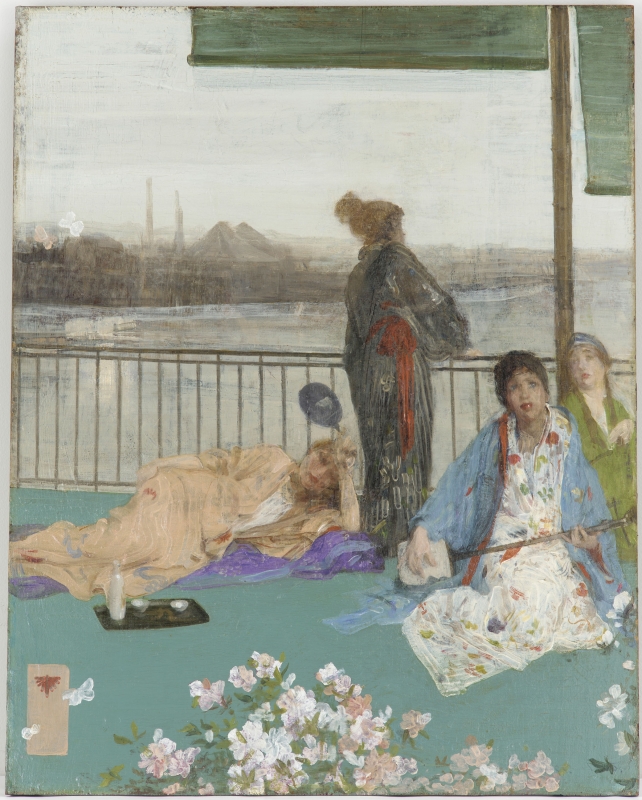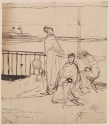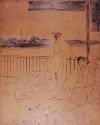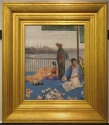Composition
A pen drawing of the composition, Sketch for 'Variations in Flesh Colour and Green: The Balcony' [M.0319], dating from about 1864, came into the collection of Samuel Putnam Avery (1822-1904). It shows that the two figures on the left were not changed much in the final design. However, the girl lying down seems to have her arm behind her back, and a blind comes down to just above the standing woman's head. The woman at the far right is seated in profile to left on a stool. The woman beside her is kneeling with her lute (shamisen) resting on her left knee. There are no blossoms, but some wood panelling is indicated in the right foreground.
A watercolour, Study for 'Variations in Flesh Colour and Green: The Balcony' [M.0320], shows an early version of the composition. The poses of the figures in the watercolour are very like those in this painting but the blossoms are still not extensive. Apparently this was so in the painting in its early state, as seen in the photograph in the Lucas Collection, Baltimore, when the picture had no butterfly signature but was signed 'Whistler. 1865.' A comparison of the drawing with the Freer painting, conducted in 1995, concluded that the drawing was traced from the painting but that it showed some variations, consistent with its being based on the painting at a slightly earlier stage.
The examination resulted in the conclusion that the painting 'is both the earliest and the latest version of the picture.' In the final state of the painting, the flowers were repainted, extended to the right and up the right side, the butterflies and cartouche added at the left, and some puffs of smoke and minor alterations made to the shoreline.
Visual and X-ray examination of the picture show numerous other alterations to the design, of which the most important is a standing figure on the left in the place of the girl lying down. The latter is a late addition, and the lines of the veranda can be seen painted through her waist. There may have been sloping masts to the left of the standing girl to right of centre, and, to her right, another standing figure. The head of the standing girl has been changed and restored, by various hands. The hanging blinds were originally lower, and the pole two inches further to the left.
It is not entirely clear in what order the two Balcony compositions were done. This is discussed by MacDonald: 'The enlarged version ("presque comme nature", almost life-size) was perhaps started but certainly not completed, and has not survived. But was the Hunterian vivid squared-up oil sketch a stage in the process of enlarging the beautiful Freer"sketch"? ' 1 Although the Sketch for 'The Balcony' [YMSM 057] was squared either for enlarging or copying, there is no further record of the enlarged version that Whistler told Fantin-Latour he intended to paint for the Salon in 1867. 2
Technique
In 1878 Whistler wrote to John Cavafy (1839-1901), about his work on it: 'Look also at the matter of the little Balcony. I borrowed it several times from your Father - and each time I worked upon it.' 3
It was painted directly on a thick course-grained wood panel without gesso preparation.
When Whistler described this painting to Fantin-Latour in 1867, what he emphasized was its colour: 'la couleur en est tres éclatante' (the colour is very brilliant). 4
For the entry on this painting in the Goupil catalogue in 1892 Whistler selected six reviews that accused his work of eccentricity, poor draughtsmanship, lack of finish, and 'predilections for dinginess and dirt'. 5 Presumably these were all criticisms that he expected this painting to refute. Walter Richard Sickert (1860-1942), indeed, raved about the still-life painting of 'the tray the saké cups' in The Balcony: 'That is what it means to be a painter!' wrote Sickert, 'To know and love your material , as a rider knows his horse or a violinist his fiddle.' 6
Conservation History
In 1892 it was probably cleaned and varnished by Stephen Richards (1844-1900), to whom Whistler sent instructions:
'Now I understand that you will have brought to you, almost directly, four more pictures by me; I have said that you are the only man fit to touch my work, therefore, you must prove again how right I am, in having this full confidence in you. You will clean and take off the varnish with the utmost care and tenderness - Two of the pictures have not been cleaned since they were first painted. They ought all to come out in the most brilliant condition. One, - "The Balcony" you can use your own judgment about.' 7
As Whistler told E. G. Kennedy, '"The Balcony" will probably be in perfect condition already - as it was in my Exhibition at Goupil's and Richards attended to all those.' 8 But Whistler still asked Richards to send the painting, unframed, to Paris in case he wanted to 'touch' it, then changed his mind and said that 'I could not possibly add in any way.' 9 In the end it is not clear if anything was done at this time, for Richards only charged Kennedy £1.10.0 (which he thought excessive) 'for looking at the Balcony', and, Kennedy added, 'He may have done something to it, but it looks just the same as when in London and it was entirely unnecessary to have done anything to it.' 10
It apparently incurred minor damage ('the wood panel had checked considerably') when shown in the Retrospective Exhibition, Society of American Artists, New York, 1892 (cat. no. 358). 11
From 1921 onwards, the painting was frequently repaired, conserved, cleaned and resurfaced at the Freer Gallery of Art. A split in the panel was glued in 1921, and the panel was cradled in the following year. The paint was in poor condition, with areas flaking, and needed considerable repair, infilling and revarnishing in 1954, 1958 and 1965, when Ben Johnson repaired, restored and retouched several areas including the badly damaged head of the standing figure before revarnishing.
Frame
- 1864: original frame, possibly made by John Green, oriental cassetta, with incised decoration, ca 1864, whereabouts unknown.
- ca 1878: reeded cassetta frame with flat frieze containing a painted seigaiha pattern and butterfly signature, made by Foord & Dickenson. It was still on the painting when it was exhibited at the Goupil exhibition in 1892. Present whereabouts unknown.
- 1892: the current Grau-style frame may have been made at the time of the 1892 Goupil exhibition or afterwards, when the dealer E. G. Kennedy had new frames made for several paintings imported to the USA. [FD] 93.9 x 81.9 cm (37 x 32 ¼"), [MW] 14.2 cm (5 5/8") 12
This frame presents a fascinating study in Whistler's framing habits. The canvas has probably possessed three different frames, of which the first two were certainly chosen by Whistler and the third, created in a style of which he approved. The first is believed to have been an oriental cassetta frame similar to those on similar works dating from 1864, such as La Princesse du pays de la porcelaine [YMSM 050] and Caprice in Purple and Gold: The Golden Screen [YMSM 060]. This was removed in the late 1870s.
The original frame was replaced with a Flat Whistler frame made by Foord & Dickinson. 13 Whistler told John Cavafy, 'Look also at the matter of the little Balcony. ... In the end I also ordered for it a new frame - and elaborately painted and ornamented it - and again the mere price of the frame was refused when Foord [sic] and Dickenson sent in his bill.' 14
This frame remained on the canvas until 1892. It is not entirely clear when the current frame was made: either in London or in New York, when E. G. Kennedy ordered new frames for several canvases he had recently purchased.
This frame may be American made, following the pattern established by Frederick Henry Grau (1859-1892), and may be the third to surround the work. 15
Notes:
1: MacDonald, Margaret F., 'The chicken and the egg', James McNeill Whistler and his Art, blog at https://jmcnwhistler.wordpress.com.
2: [June/July 1867], GUW #08045.
3: [July/October 1878], GUW #00549.
4: [June/July 1867], GUW #08045.
5: Nocturnes, Marines & Chevalet Pieces, Goupil Gallery, London, 1892 (cat. no. 40).
6: W. Sickert 1892 [more] ; W. Sickert 2000 [more] , pp. 94-95.
8: Whistler to E. G. Kennedy, 13 [June] 1892, GUW #09685.
9: [27 June 1892] and [28 June 1892], GUW #05189 and #10715.
10: Kennedy to Whistler, 26 October 1892, and 29 October 1892, GUW #07203 and #07204.
11: C. L. Freer to Whistler, 9 January 1894, GUW #01506.
12: Dr Sarah L. Parkerson Day, Report on frames, 2017.
13: Ibid.
14: Whistler to J. Cavafy, [July/October 1878], GUW #00549.
15: Parkerson 2017, op. cit.
Last updated: 8th June 2021 by Margaret











